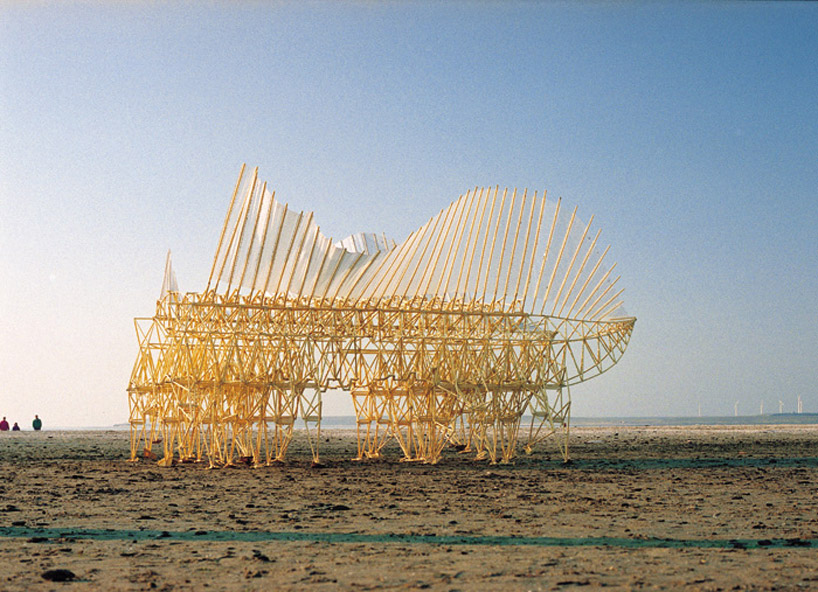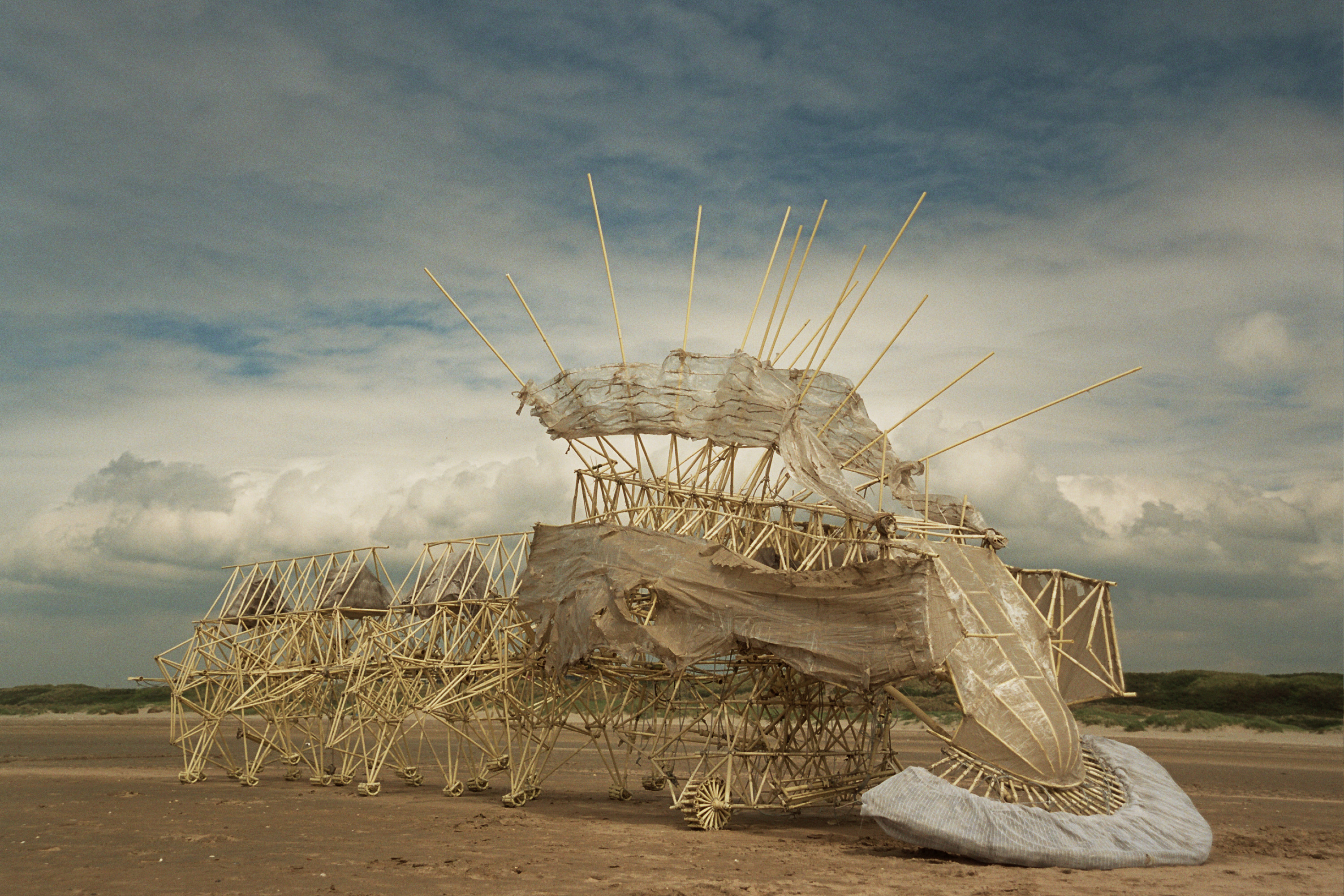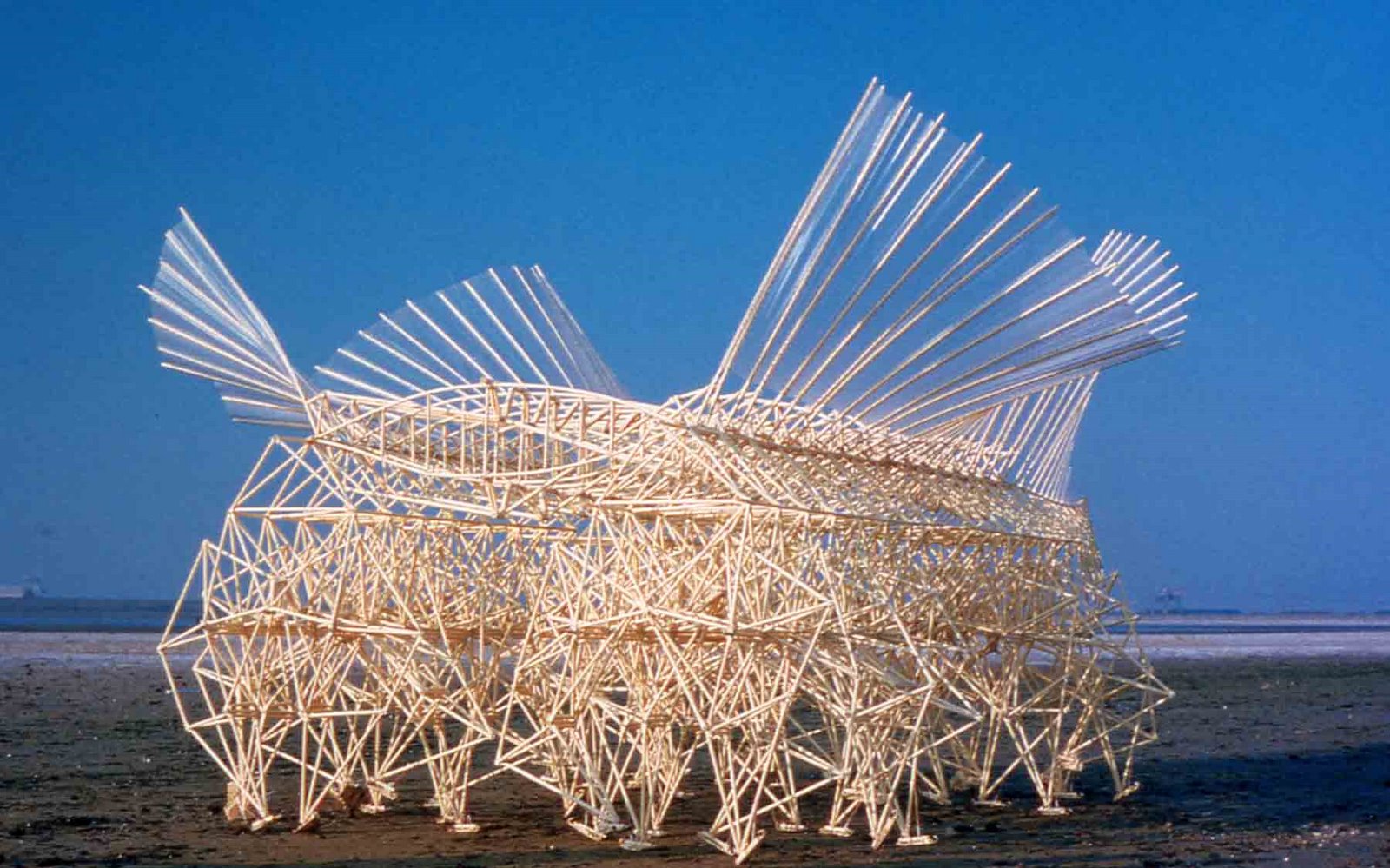Theo Jansen, a dropout physicist become artist, has created his very own aesthetic. In 1980, Jansen began with 1500 combinations of 11 linkage sizes. Using a new technology at the time, a computer was utilized to dwindle the different configurations down to just one golden combination, the “eleven holy numbers”. These numbers allowed for the most efficient, elegant, and stable motion of what would thereafter become the locomotion of the Strandbeest. Watching his PVC creatures move both invokes curiosity and mesmerizes. They appear to move across the beach eloquently and naturally, making it difficult to remember that these actually aren’t living creatures or an alien from beyond.

Jansen is constantly creating new “species”. He refers to them as living creatures with a “stomach”, “muscles”, and even have the ability to multiply. Each species he creates has an unique aesthetic and usually a new function. He has begun designing his creatures to flea rising tides and even secure themselves during a storm.
Most of his work is done in Ypenburg, Netherlands. Jansen has a small cabin, a shipping container, and a small sandy area to test some of the infantile Strandbeests. As one can imagine, these beasts require exceptional amounts of effort to build. So Jansen does have the occasional associate help him with construction, but these creatures are of his own design.

Trial and error were Janson’s original source of evolution in his walking creatures. Increases in computing power has allowed Jansen to accelerate the advancement of his walking creatures in recent years leading to the large structures you can see him tinkering with today.

His machines are barely machines at all. There is no electricity, no motors, no CPU to control the “creatures” movements. Jansen was driven by his desire to unravel the mystery of the way organisms seemingly move effortlessly. An the result is definitely on par with his goal. His design has an outsider art feel to it, possible mixed with what I would categorize as a range from an island tribal aesthetic, to insect like, and all the way around to something resembling modern architecture or industrial. This is definitely a unique aesthetic, one that is hard to describe to a person who hasn’t experienced it.

The “eleven holy numbers” and Jansen’s design are available for public use. This has allowed for what he considers to be the ability for his creations to multiply (as mentioned earlier). Anyone can build one, and anyone can make it their own. You can even find desktop versions in model kits for purchase of all sorts of varieties.
Theo Jansen has found a way to portray life as an abstract kinetic sculpture. His Strandbeests don’t resemble any life form I have witnessed, yet I find myself imagining these large artificial creatures as having life. I see one fall over and catch myself felling sorry for it… its the strangest thing how the aesthetic Jansen has created can make a person feel empathy for a creature made of PVC, wood, and cloth. To myself, it is mesmerizing both because of the work, science, and engineering as well as the aesthetic, beauty, and awe in his design.
All information was found from:
Jansen, Theo. “Mini Beasts | Books Beast Photos Events Theo Jansen Contact.”STRANDBEEST. N.p., n.d. Web. 24 Jan. 2017.
Videos:
Strandbeestfilm. “Strandbeest Evolution.” YouTube. YouTube, 04 June 2013. Web. 24 Jan. 2017.
TEDxTalks. “A New Breed of Beach Animals | Theo Jansen | TEDxDelft.” YouTube. YouTube, 25 Nov. 2011. Web. 24 Jan. 2017.
Photos:
No photographer or publisher information could be found on the photos, URL sources can be found in captions


6 Comments. Leave new
[…] Image Source: Blake Arellano […]
[…] the walking machine inspired by Theo Jansen (if you are unfamiliar, check my previous posts Overview of Strandbeest by Theo Jansen and Upcycle Thoughts: Kinetic Walking Sculpture). On the way to my goal, I had found that the […]
[…] holy numbers” away for the public to use however they see fit (See my previous post “Aesthetic Explorations: Theo Jansen and His Strandbeest” for more information on his creations). Shown below, the 11 numbers for a linkage system for […]
When I first saw the Strandbeest video several years ago, it blew my mind. I could not fathom how the mechanism “walked” until recently when I learned the movements made by connecting multiple linkages together. I find it fascinating that the magic number of linkages, eleven, could be used to create this motion even though eleven is not usually a unique or symmetric number in many applications. Great post!
I too felt the empathy toward these creatures as they walk or crawled across the sand in the videos. How these creates move is mind boggling to me! Like Kira mentioned, curious as to how they get moving, seems like it is the wind giving them a push. However, in the first video you can see a guy pulling one. Is that all that is needed to get the creatures moving?
Hello Blake, I liked the video a lot: it’s really neat to watch them move around! So, if these beasts are not machines (no CPU, motors, etc.) how do they move around, perhaps the wind? Also the “eleven holy numbers” concept was a little confusing. What does a golden combination mean exactly? Some more details would be welcome, but really cool topic!